Comparative Cell Wall Polysaccharide Analyses and Transcriptome Profiling during Fruit Ripening Reveal the Molecular Basis of Mealiness in Peach
Abstract
:1. Introduction
2. Materials and Methods
2.1. Plant Material and Fruit Sampling
2.2. Evaluation of Ethylene Production, Flesh Firmness, and Mealiness
2.3. Analysis of Fruit Flesh Microstructure
2.4. Extraction and Fractionation of Cell Wall Material (CWM)
2.5. Enzyme Activity Measurements
2.6. Acid Hydrolysis of Polysaccharides and Neutral Sugars
2.7. RNA-Seq and Data Analysis
2.8. Identification and Functional Analysis of Differentially Expressed Genes (DEGs)
2.9. Weighted Gene Co-Expression Network Analysis (WGCNA)
2.10. Statistical Analysis
3. Results
3.1. Textural and Physiological Changes in Peach Fruit Flesh during Ripening
3.2. Analysis of Cell Wall Composition
3.3. Cell Wall Enzyme Activity
3.4. Neutral Sugar Composition of Cell Walls
3.5. Identification and Functional Enrichment Analysis of DEGs
3.6. Comparative Transcriptome Profiling of DEGs Associated with Cell Wall Polysaccharide Decomposition in Mealy and Non-Mealy Peaches
3.7. Expression of Key Genes Related to Cell Wall Metabolism and Ethylene Biosynthesis
3.8. WGCNA-Based Identification of Co-Expression Network Modules Regulating Mealiness
4. Discussion
5. Conclusions
Supplementary Materials
Author Contributions
Funding
Data Availability Statement
Acknowledgments
Conflicts of Interest
References
- Monti, L.L.; Bustamante, C.A.; Osorio, S.; Gabilondo, J.; Borsani, J.; Lauxmann, M.A.; Maulión, E.; Valentini, G.; Budde, C.O.; Fernie, A.R.; et al. Metabolic profiling of a range of peach fruit varieties reveals high metabolic diversity and commonalities and differences during ripening. Food Chem. 2016, 190, 879–888. [Google Scholar] [CrossRef] [PubMed]
- Lester, D.R.; Sherman, W.B.; Atwell, B.J. Endopolygalacturonase and the Melting Flesh (M) Locus in Peach. J. Am. Soc. Hortic. Sci. 1996, 121, 231–235. [Google Scholar] [CrossRef]
- Haji, T.; Yaegaki, H.; Yamaguchi, M. Inheritance and expression of fruit texture melting, non-melting and stony hard in peach. Sci. Hortic. 2005, 105, 241–248. [Google Scholar] [CrossRef]
- Yoshioka, H.; Hayama, H.; Tatsuki, M.; Nakamura, Y. Cell wall modification during development of mealy texture in the stony-hard peach “Odoroki” treated with propylene. Postharvest Biol. Technol. 2010, 55, 1–7. [Google Scholar] [CrossRef]
- Brummell, D.A.; Cin, V.D.; Crisosto, C.H.; Labavitch, J.M. Cell wall metabolism during maturation, ripening and senescence of peach fruit. J. Exp. Bot. 2004, 55, 2029–2039. [Google Scholar] [CrossRef] [PubMed]
- Haji, T.; Yaegaki, H.; Yamaguchi, M. Changes in ethylene production and flesh firmness of melting, non-melting and stony hard peaches after harvest. J. Jpn. Soc. 2001, 70, 458–459. [Google Scholar]
- Haji, T.; Yaegaki, H.; Yamaguchi, M. Softening of Stony Hard Peach by Ethylene and the Induction of Endogenous Ethylene by 1-Aminocyclopropane-1-Carboxylic Acid (ACC). J. Jpn. Soc. Hortic. Sci. 2003, 72, 212–217. [Google Scholar] [CrossRef]
- Moriya, S.; Kunihisa, M.; Okada, K.; Iwanami, H.; Iwata, H.; Minamikawa, M.; Katayose, Y.; Matsumoto, T.; Mori, S.; Sasaki, H.; et al. Identification of QTLs for Flesh Mealiness in Apple (Malus × domestica Borkh.). Hortic. J. 2017, 86, 159–170. [Google Scholar] [CrossRef]
- Kim, M.S.; Duizer, L.M.; Grygorczyk, A. Application of a Texture Analyzer friction rig to evaluate complex texture attributes in apples. Postharvest Biol. Technol. 2022, 186, 111820. [Google Scholar] [CrossRef]
- Segonne, S.M.; Bruneau, M.; Celton, J.-M.; Le Gall, S.; Francin-Allami, M.; Juchaux, M.; Laurens, F.; Orsel, M.; Renou, J.-P. Multiscale investigation of mealiness in apple: An atypical role for a pectin methylesterase during fruit maturation. BMC Plant Biol. 2014, 14, 375. [Google Scholar] [CrossRef]
- Devaux, M.F.; Barakat, A.; Robert, P.; Bouchet, B.; Guillon, F.; Navez, B.; Lahaye, M. Mechanical breakdown and cell wall structure of mealy tomato pericarp tissue. Postharvest Biol. Technol. 2005, 37, 209–221. [Google Scholar] [CrossRef]
- Soteriou, G.A.; Siomos, A.S.; Gerasopoulos, D.; Rouphael, Y.; Georgiadou, S.; Kyriacou, M.C. Biochemical and histological contributions to textural changes in watermelon fruit modulated by grafting. Food Chem. 2017, 237, 133–140. [Google Scholar] [CrossRef] [PubMed]
- Ben-Arie, R.; Sonego, L. Pectolytic enzyme activity involved in woolly breakdown of stored peaches. Phytochemistry 1980, 19, 2553–2555. [Google Scholar] [CrossRef]
- Ben-Arie, R.; Lavee, S. Pectic changes occurring in elberta peaches suffering from woolly breakdown. Phytochemistry 1971, 10, 531–538. [Google Scholar] [CrossRef]
- Li, S.; Li, Q.; Cao, J.; Qu, G.; Jiang, W. Comparative transcriptomic analysis provides novel insights into the difference in textural alteration between mealy and crisp apple patterns. Food Res. Int. 2023, 169, 112941. [Google Scholar] [CrossRef] [PubMed]
- Brummell, D.A.; Dal Cin, V.; Lurie, S.; Crisosto, C.H.; Labavitch, J.M. Cell wall metabolism during the development of chilling injury in cold-stored peach fruit: Association of mealiness with arrested disassembly of cell wall pectins. J. Exp. Bot. 2004, 55, 2041–2052. [Google Scholar] [CrossRef] [PubMed]
- Lurie, S.; Crisosto, C.H. Chilling injury in peach and nectarine. Postharvest Biol. Technol. 2005, 37, 195–208. [Google Scholar] [CrossRef]
- Lurie, S.; Zhou, H.W.; Lers, A.; Sonego, L.; Alexandrov, S.; Shomer, I. Study of pectin esterase and changes in pectin methylation during normal and abnormal pleach ripening. Physiol. Planta. 2003, 119, 287–294. [Google Scholar] [CrossRef]
- Obenland, D.M.; Crisosto, C.H.; Rose, J.K. Expansin protein levels decline with the development of mealiness in peaches. Postharvest Biol. Technol. 2003, 29, 11–18. [Google Scholar] [CrossRef]
- Zheng, Y.L.; Duan, L.H.; Ran, Y.L.; Zhang, P.; Jiang, Y.B.; Zhao, Z.Y.; Jia, X.Y. Transcriptomics analysis reveals molecular mechanism of softening and cell wall polysaccharides-disassembling in peaches treated by flow microcirculation of sodium nitroprusside medium. Postharvest Biol. Technol. 2023, 196, 112190. [Google Scholar] [CrossRef]
- Gwanpua, S.G.; Verlinden, B.E.; Hertog, M.L.A.T.M.; Nicolai, B.M.; Hendrickx, M.; Geeraerd, A. A transcriptomics-based kinetic model for enzyme-induced pectin degradation in apple (Malus × domestica) fruit. Postharvest Biol. Technol. 2017, 130, 64–74. [Google Scholar] [CrossRef]
- Cao, X.; Li, X.; Su, Y.; Zhang, C.; Wei, C.; Chen, K.; Grierson, D.; Zhang, B. Transcription factor PpNAC1 and DNA demethylase PpDML1 synergistically regulate peach fruit ripening. Plant Physiol. 2023, 194, 2049–2068. [Google Scholar] [CrossRef]
- Morgutti, S.; Negrini, N.; Nocito, F.F.; Ghiani, A.; Bassi, D.; Cocucci, M. Changes in endopolygalacturonase levels and character-ization of a putative endo-PG gene during fruit softening in peach genotypes with nonmelting and melting flesh fruit phenotypes. New Phytol. 2006, 171, 315–328. [Google Scholar] [CrossRef]
- Dheilly, E.; Le Gall, S.; Guillou, M.-C.; Renou, J.-P.; Bonnin, E.; Orsel, M.; Lahaye, M. Cell wall dynamics during apple development and storage involves hemicellulose modifications and related expressed genes. BMC Plant Biol. 2016, 16, 201. [Google Scholar] [CrossRef] [PubMed]
- Rothkegel, K.; Espinoza, A.; Sanhueza, D.; Lillo-Carmona, V.; Riveros, A.; Campos-Vargas, R.; Meneses, C. Identification of DNA Methylation and Transcriptomic Profiles Associated with Fruit Mealiness in Prunus persica (L.) Batsch. Front. Plant Sci. 2021, 12, 684130. [Google Scholar] [CrossRef] [PubMed]
- Nuñez-Lillo, G.; Cifuentes-Esquivel, A.; Troggio, M.; Micheletti, D.; Infante, R.; Campos-Vargas, R.; Orellana, A.; Blanco-Herrera, F.; Meneses, C. Identification of candidate genes associated with mealiness and maturity date in peach [Prunus persica (L.) Batsch] using QTL analysis and deep sequencing. Tree Genet. Genomes 2015, 11, 86. [Google Scholar] [CrossRef]
- Nuñez-Lillo, G.; Balladares, C.; Pavez, C.; Urra, C.; Sanhueza, D.; Vendramin, E.; Dettori, M.T.; Arús, P.; Verde, I.; Blanco-Herrera, F.; et al. High-density genetic map and QTL analysis of soluble solid content, maturity date, and mealiness in peach using genotyping by sequencing. Sci. Hortic. 2019, 257, 108734. [Google Scholar] [CrossRef]
- Zhang, R.; Liu, Y.; Zhang, X.; Chen, X.; Sun, J.; Zhao, Y.; Zhang, J.; Yao, J.; Liao, L.; Zhou, H.; et al. Two adjacent NAC transcription factors regulate fruit maturity date and flavor in peach. New Phytol. 2024, 241, 632–649. [Google Scholar] [CrossRef]
- Li, S.; Chen, K.; Grierson, D. Molecular and Hormonal Mechanisms Regulating Fleshy Fruit Ripening. Cells 2021, 10, 1136. [Google Scholar] [CrossRef]
- Li, Z.; Jiang, G.; Liu, X.; Ding, X.; Zhang, D.; Wang, X.; Zhou, Y.; Yan, H.; Li, T.; Wu, K.; et al. Histone demethylase SlJMJ6 promotes fruit ripening by removing H3K27 methylation of ripening-related genes in tomato. New Phytol. 2020, 227, 1138–1156. [Google Scholar] [CrossRef]
- Zeng, W.; Pan, L.; Liu, H.; Niu, L.; Lu, Z.; Cui, G.; Wang, Z. Characterization of 1-aminocyclopropane-1-carboxylic acid synthase (ACS) genes during nectarine fruit development and ripening. Tree Genet. Genomes 2015, 11, 1–10. [Google Scholar] [CrossRef]
- Ng, J.K.; Schröder, R.; Sutherland, P.W.; Hallett, I.C.; Hall, M.I.; Prakash, R.; Smith, B.G.; Melton, L.D.; Johnston, J.W. Cell wall structures leading to cultivar differences in softening rates develop early during apple (Malus × domestica) fruit growth. BMC Plant Biol. 2013, 19, 183. [Google Scholar] [CrossRef] [PubMed]
- Li, Q.; Xu, R.; Fang, Q.; Yuan, Y.; Cao, J.; Jiang, W. Analyses of microstructure and cell wall polysaccharides of flesh tissues provide insights into cultivar difference in mealy patterns developed in apple fruit. Food Chem. 2020, 321, 126707. [Google Scholar] [CrossRef] [PubMed]
- Santiago-Doménech, N.; Jiménez-Bermúdez, S.; Matas, A.J.; Rose, J.K.C.; Muñoz-Blanco, J.; Mercado, J.A.; Quesada, M.A. Anti-sense inhibition of a pectate lyase gene supports a role for pectin depolymerization in strawberry fruit softening. J. Exp. Bot. 2008, 59, 2769–2779. [Google Scholar] [CrossRef] [PubMed]
- Li, Q.; Li, J.; Li, H.; Xu, R.; Yuan, Y.; Cao, J. Physicochemical properties and functional bioactivities of different bonding state polysaccharides extracted from tomato fruit. Carbohydr. Polym. 2019, 219, 181–190. [Google Scholar] [CrossRef] [PubMed]
- Zhou, H.W.; Sonego, L.; Khalchitski, A.; Ben-Arie, R.; Lers, A.; Lurie, S. Cell wall enzymes and cell wall changes in ‘Flavortop’ nectarines-mRNA abundance, enzyme activity, and changes in pectic and neutral polymers during ripening and in wooly fruit. J. Am. Soc. Hortic. Sci. 2000, 125, 630–637. [Google Scholar] [CrossRef]
- Li, Q.; Yao, S.; Deng, L.; Zeng, K. Changes in biochemical properties and pectin nanostructures of juice sacs during the granulation process of pomelo fruit (Citrus grandis). Food Chem. 2022, 376, 131876. [Google Scholar] [CrossRef]
- Miller, G.L. Use of Dinitrosalicylic Acid Reagent for Determination of Reducing Sugar. Anal. Chem. 1959, 31, 426–428. [Google Scholar] [CrossRef]
- Ortiz, A.; Graell, J.; Lara, I. Cell wall-modifying enzymes and firmness loss in ripening ‘Golden Reinders’ apples: A comparison between calcium dips and ULO storage. Food Chem. 2011, 128, 1072–1079. [Google Scholar] [CrossRef]
- Duan, X.; Cheng, G.; Yang, E.; Yi, C.; Ruenroengklin, N.; Lu, W.; Luo, Y.; Jiang, Y. Modification of pectin polysaccharides during ripening of postharvest banana fruit. Food Chem. 2008, 111, 144–149. [Google Scholar] [CrossRef]
- Manrique, G.D.; Lajolo, F.M. Cell-wall polysaccharide modifications during postharvest ripening of papaya fruit (Carica papaya). Postharvest Biol. Technol. 2004, 33, 11–26. [Google Scholar] [CrossRef]
- Niu, L.; Pan, L.; Zeng, W.; Lu, Z.; Cui, G.; Fan, M.; Xu, Q.; Wang, Z.; Li, G. Dynamic transcriptomes of resistant and susceptible peach lines after infestation by green peach aphids (Myzus persicae Sülzer) reveal defence responses controlled by the Rm3 locus. BMC Genom. 2018, 19, 846. [Google Scholar] [CrossRef] [PubMed]
- Li, L.; Yi, P.; Sun, J.; Tang, J.; Liu, G.M.; Bi, J.F.; Ling, D.N. Genome-wide transcriptome analysis uncovers gene networks regulating fruit quality and volatile compounds in mango cultivar ‘Tainong’ during postharvest. Food Research International. 2023, 165, 112531. [Google Scholar] [CrossRef] [PubMed]
- Langfelder, P.; Horvath, S. WGCNA: An R package for weighted correlation network analysis. BMC Bioinform. 2008, 9, 559. [Google Scholar] [CrossRef] [PubMed]
- Ma, L.; Zhang, M.; Chen, J.; Qing, C.; He, S.; Zou, C.; Yuan, G.; Yang, C.; Peng, H.; Pan, G.; et al. GWAS and WGCNA uncover hub genes controlling salt tolerance in maize (Zea mays L.) seedlings. Theor. Appl. Genet. 2021, 134, 3305–3318. [Google Scholar] [CrossRef] [PubMed]
- Win, N.M.; Yoo, J.; Naing, A.H.; Kwon, J.G.; Kang, I.K. 1-Methylcyclopropene (1-MCP) treatment delays modification of cell wall pectin and fruit softening in “Hwangok” and “Picnic” apples during cold storage. Postharvest Biology and Technology. 2021, 180, 111599. [Google Scholar] [CrossRef]
- Goulao, L.F.; Oliveira, C.M. Cell wall modifications during fruit ripening: When a fruit is not the fruit. Trends Food Sci. Technol. 2008, 19, 4–25. [Google Scholar] [CrossRef]
- Yoshioka, H.; Aoba, K.; Kashimura, Y. Molecular Weight and Degree of Methoxylation in Cell Wall Polyuronide during Softening in Pear and Apple Fruit. J. Am. Soc. Hortic. Sci. 1992, 117, 600–606. [Google Scholar] [CrossRef]
- Scalzo, R.; Forni, L.E.; Lupi, D.; Giudetti, G.; Testoni, A. Changes of pectic composition of ‘Annurca’ apple fruit after storage. Food Chem. 2005, 93, 521–530. [Google Scholar] [CrossRef]
- Orr, G.; Brady, C. Relationship of endopolygalacturonase activity to fruit softening in a freestone peach. Postharvest Biol. Technol. 1993, 3, 121–130. [Google Scholar] [CrossRef]
- Hayama, H.; Tatsuki, M.; Ito, A.; Kashimura, Y. Ethylene and fruit softening in the stony hard mutation in peach. Postharvest Biol. Technol. 2006, 41, 16–21. [Google Scholar] [CrossRef]
- Atkinson, R.G.; Sutherland, P.W.; Johnston, S.L.; Gunaseelan, K.; Hallett, I.C.; Mitra, D.; Schaffer, R.J. Down-regulation of POLY-GALACT URONASE1 alters firmness, tensile strength and water loss in apple (Malus × domestica) fruit. BMC Plant Biology. 2012, 12, 129. [Google Scholar] [CrossRef] [PubMed]
- Obenland, D.M.; Carroll, T.R. Mealiness and Pectolytic Activity in Peaches and Nectarines in Response to Heat Treatment and Cold Storage. J. Am. Soc. Hortic. Sci. 2000, 125, 723–728. [Google Scholar] [CrossRef]
- Dong, L.; Zhou, H.W.; Sonego, L.; Lers, A.; Lurie, S. Ethylene involvement in the cold storage disorder of ‘Flavortop’ nectarine. Postharvest Biol. Technol. 2001, 23, 105–115. [Google Scholar] [CrossRef]
- Yue, P.T.; Lu, Q.; Liu, Z.; Lv, T.X.; Li, X.Y.; Bu, H.D.; Liu, W.T.; Xu, Y.X.; Yuan, H.; Wang, A.D. Auxin-activated MdARF5 induces the expression of ethylene biosynthetic genes to initiate apple fruit ripening. New Phytol. 2020, 226, 1781–1795. [Google Scholar] [CrossRef] [PubMed]
- Kou, J.; Zhao, Z.; Zhang, Q.; Wei, C.; Ference, C.M.; Guan, J.; Wang, W. Comparative transcriptome analysis reveals the mechanism involving ethylene and cell wall modification related genes in Diospyros kaki fruit firmness during ripening. Genomics 2021, 113, 552–563. [Google Scholar] [CrossRef]
- Zhou, H.; Lin-Wang, K.; Wang, H.; Gu, C.; Dare, A.P.; Espley, R.V.; He, H.; Allan, A.C.; Han, Y. Molecular genetics of blood-fleshed peach reveals activation of anthocyanin biosynthesis by NAC transcription factors. Plant J. 2015, 82, 105–121. [Google Scholar] [CrossRef]
- Wang, J.; Cao, K.; Li, Y.; Wu, J.; Li, W.; Wang, Q.; Zhu, G.; Fang, W.; Chen, C.; Wang, X.; et al. Genome variation and LTR-RT analyses of an ancient peach landrace reveal mechanism of blood flesh fruit color formation and fruit maturity date advancement. Hortic. Res. 2023, 11, uhad265. [Google Scholar] [CrossRef]

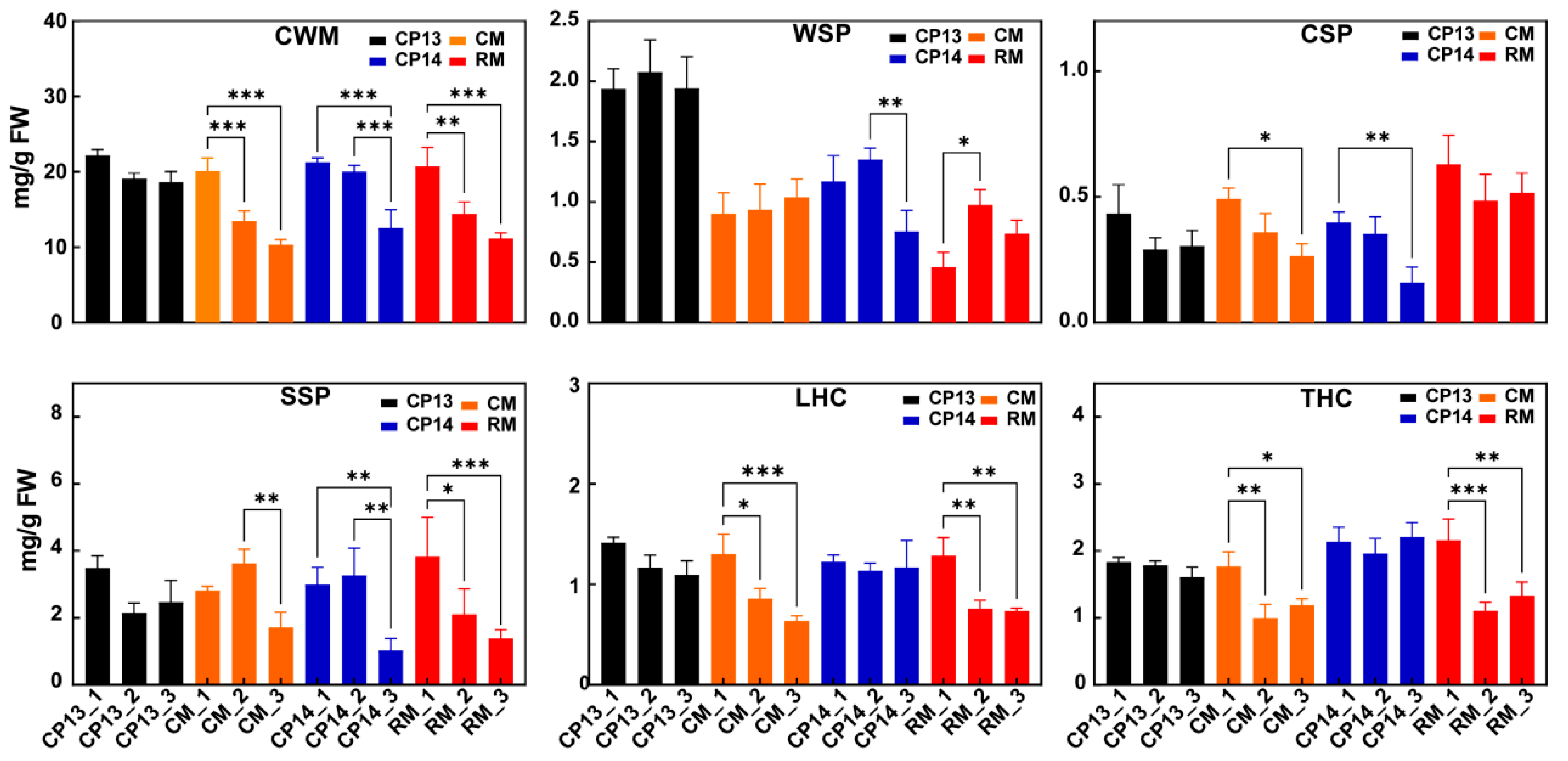
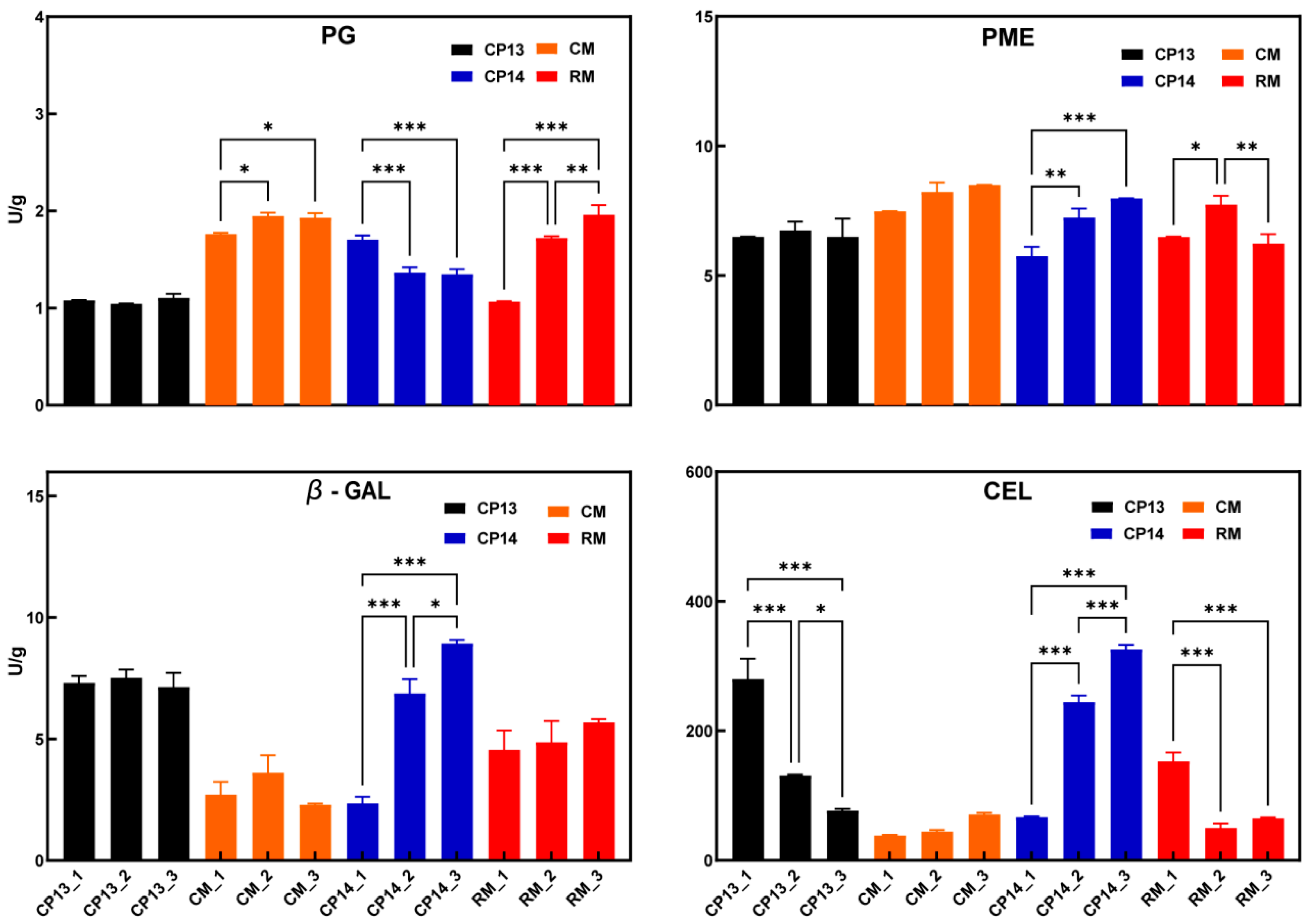
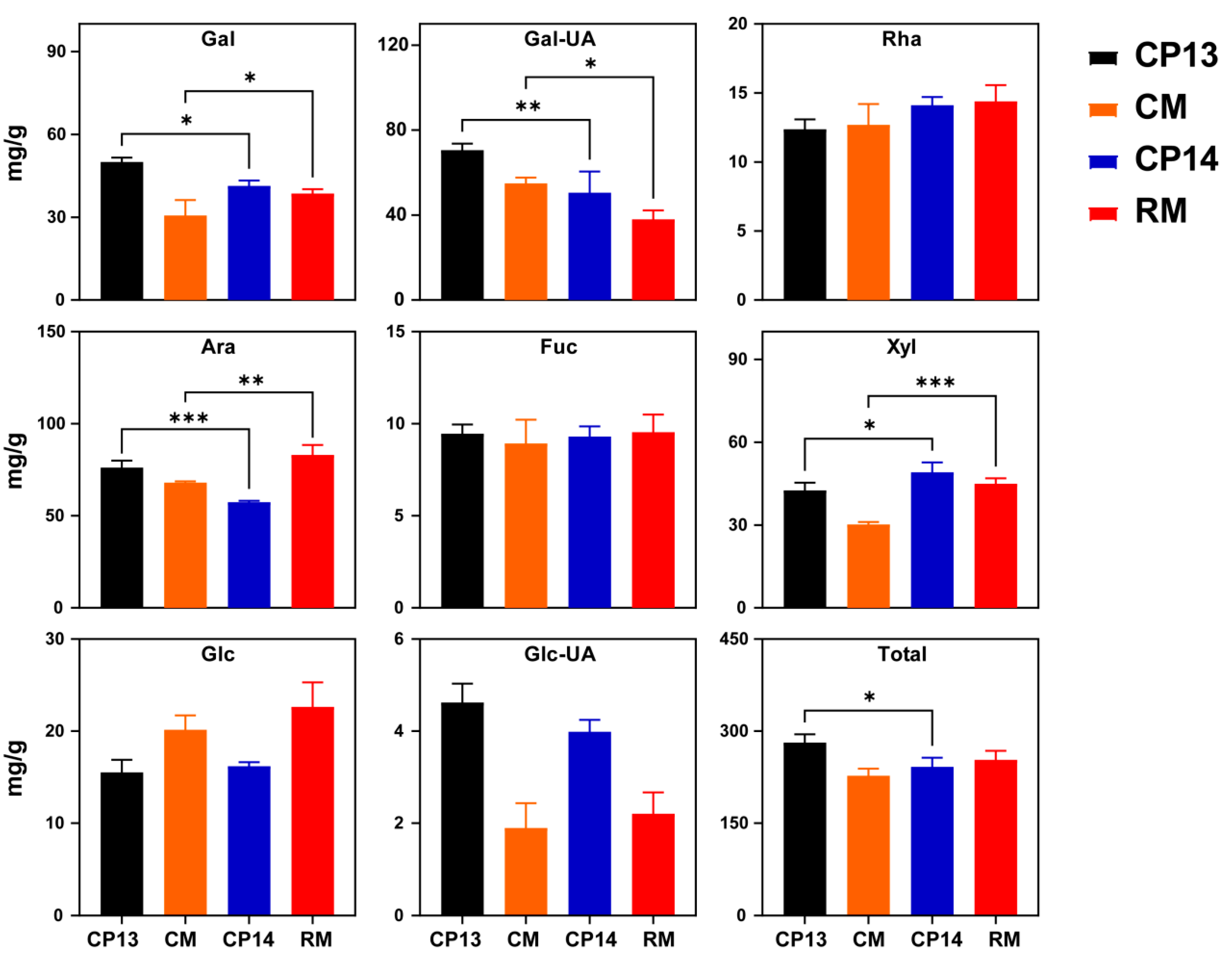

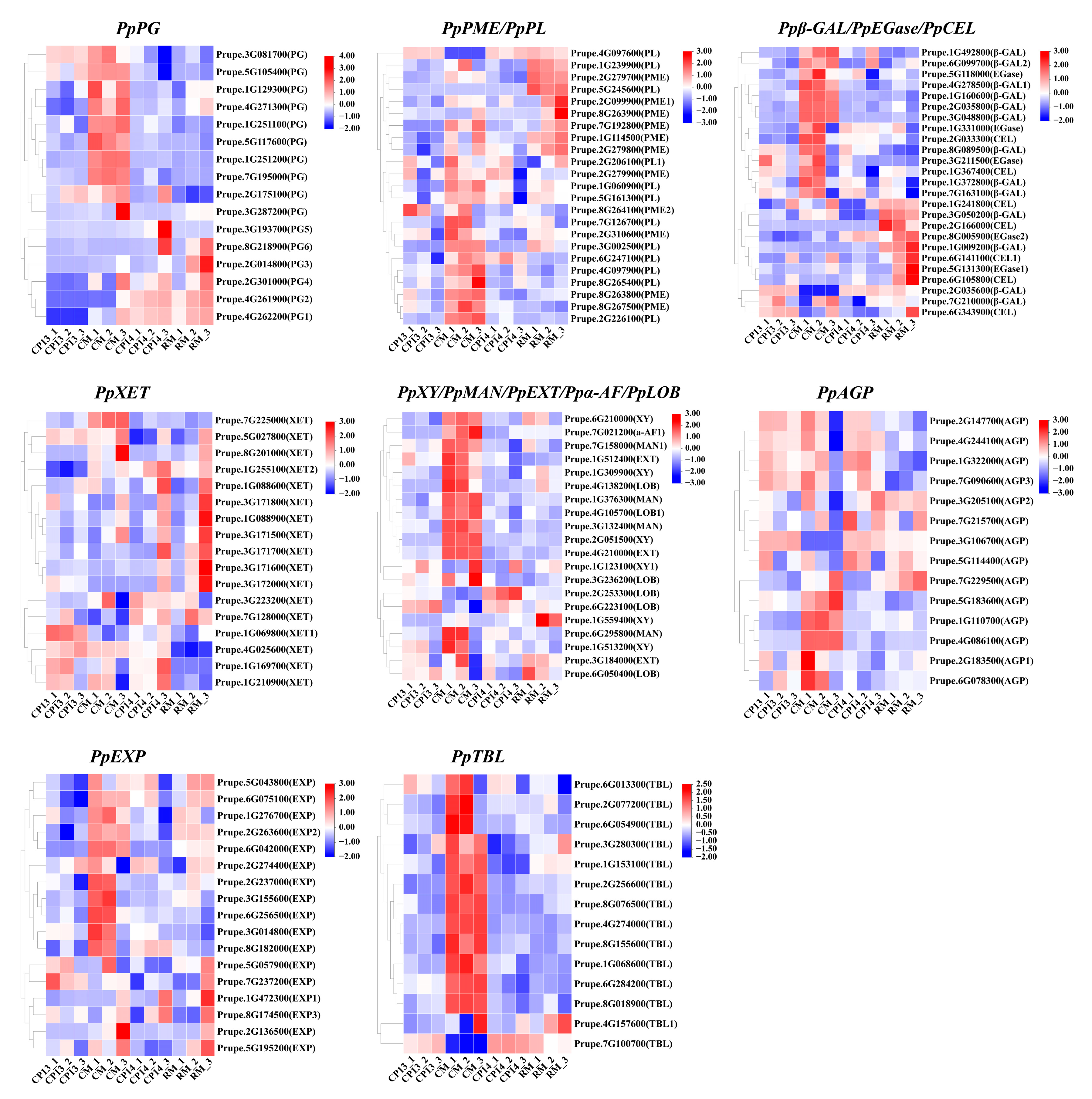
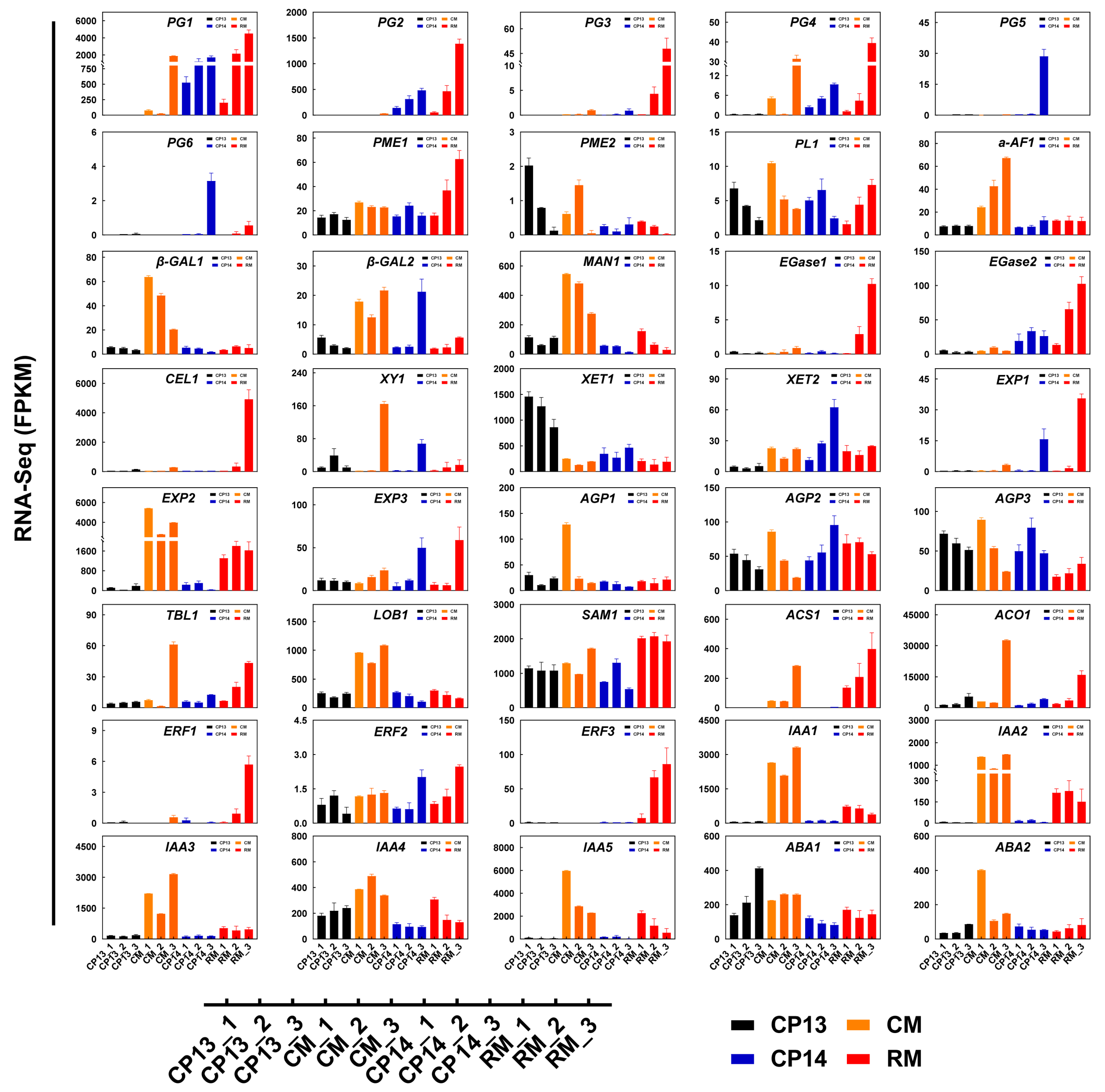

Disclaimer/Publisher’s Note: The statements, opinions and data contained in all publications are solely those of the individual author(s) and contributor(s) and not of MDPI and/or the editor(s). MDPI and/or the editor(s) disclaim responsibility for any injury to people or property resulting from any ideas, methods, instructions or products referred to in the content. |
© 2024 by the authors. Licensee MDPI, Basel, Switzerland. This article is an open access article distributed under the terms and conditions of the Creative Commons Attribution (CC BY) license (https://creativecommons.org/licenses/by/4.0/).
Share and Cite
Wang, H.; Li, A.; Zeng, W.; Yao, Z.; Badrunnesa, A.; Meng, J.; Miao, Y.; Niu, L.; Pan, L.; Cui, G.; et al. Comparative Cell Wall Polysaccharide Analyses and Transcriptome Profiling during Fruit Ripening Reveal the Molecular Basis of Mealiness in Peach. Horticulturae 2024, 10, 615. https://doi.org/10.3390/horticulturae10060615
Wang H, Li A, Zeng W, Yao Z, Badrunnesa A, Meng J, Miao Y, Niu L, Pan L, Cui G, et al. Comparative Cell Wall Polysaccharide Analyses and Transcriptome Profiling during Fruit Ripening Reveal the Molecular Basis of Mealiness in Peach. Horticulturae. 2024; 10(6):615. https://doi.org/10.3390/horticulturae10060615
Chicago/Turabian StyleWang, Hongmei, Ang Li, Wenfang Zeng, Zhenyu Yao, Akhi Badrunnesa, Junren Meng, Yule Miao, Liang Niu, Lei Pan, Guochao Cui, and et al. 2024. "Comparative Cell Wall Polysaccharide Analyses and Transcriptome Profiling during Fruit Ripening Reveal the Molecular Basis of Mealiness in Peach" Horticulturae 10, no. 6: 615. https://doi.org/10.3390/horticulturae10060615
APA StyleWang, H., Li, A., Zeng, W., Yao, Z., Badrunnesa, A., Meng, J., Miao, Y., Niu, L., Pan, L., Cui, G., Duan, W., Sun, S., Li, G., & Wang, Z. (2024). Comparative Cell Wall Polysaccharide Analyses and Transcriptome Profiling during Fruit Ripening Reveal the Molecular Basis of Mealiness in Peach. Horticulturae, 10(6), 615. https://doi.org/10.3390/horticulturae10060615





